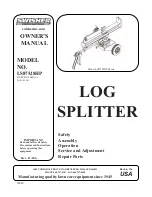
www.scheppach.com /
+(49)-08223-4002-99 /
+(49)-08223-4002-58
GB | 25
•
Now you can roll a new log onto the log lifter.
Resetting the log lifter
This is used as a second guard arm when not using
the trunk lifter. For this, the arm is moved up until it
locks in.
Transport position of the log lifter:
•
Using your hand, move the log lifter up until it locks
in position.
Comply with these notices to ensure quick and
safe work.
11. Electrical connection
The electrical motor installed is connected and ready
for operation. The connection complies with the ap-
plicable VDE and DIN provisions.
The customer‘s mains connection as well as the ex-
tension cable used must also comply with these reg
-
ulations.
Damaged electrical connection cable
The insulation on electrical connection cables is of-
ten damaged.
This may have the following causes:
• Passage points, where connection cables are
passed through windows or doors.
• Kinks where the connection cable has been im-
properly fastened or routed.
• Places where the connection cables have been cut
due to being driven over.
•
Insulation damage due to being ripped out of the
wall outlet.
• Cracks due to the insulation ageing.
Such damaged electrical connection cables must not
be used and are life-threatening due to the insula-
tion damage.
Check the electrical connection cables for damage
regularly. Make sure that the connection cable does
not hang on the power network during the inspection.
Electrical connection cables must comply with the
applicable VDE and DIN provisions. Only use con
-
nection cables with the marking „
H07RN
“.
The printing of the type designation on the connec
-
tion cable is mandatory.
For single-phase AC motors, we recommend a fuse
rating of 16A (C) or 16A (K) for machines with a high
starting current (starting from 3000 watts)!
Three-phase motor 400 V / 50 Hz
Mains voltage 400 V / 50 Hz
Mains voltage and extension cables must be 5-lead
(3P + N + SL (3/N/PE). Extension cables must have
a minimum cross-section of 1.5 mm². Mains fuse pro
-
tection is 16 A maximum.
•
When you push both operating levers down, the
splitting blade goes down and splits the wood.
•
Only ever split logs that have been sawn off straight.
•
Split the log vertically.
•
Never split it lying down or diagonally to the grain!
•
Wear suitable gloves and safety boots when split
-
ting wood.
•
Split very misshapen logs from the edge.
Caution: During splitting, some logs can be un
-
der significant tension and suddenly break.
• Force jammed logs out by applying pressure in
the splitting direction or by raising the riving
knife. In this case, only push the handles up,
do not use the return bracket. Caution: Risk of
injury
Using the retaining claw (fig. 12)
During the splitting process, the wood (B) must
not be held in position with hands or feet. Use
the retaining claw for this (15). To do this, pro
-
ceed as follows:
1.
Move the splitting wedge (9) a short way over the
wood to be split (B / max. 1 cm) using both oper
-
ating handles (2).
2.
Place the retaining claw (15) on the splitting
wedge (9).
3.
Push the retaining claw (15) into the wood to be
split (B) using the tensioning lever. The attach
-
ment points for the tensioning lever (16) is the
bolts (A).
4. Continue the splitting process using both operat-
ing levers (2).
5.
Remove the retaining claw from the wood (B) be
-
fore pressing the return lever (3).
Operating the log lifter (5)
General information about the log lifter:
•
For safety reasons, the log lifter chain may only be
hung on the splitting blade with the last link.
•
Ensure that nobody else is within the working envi
-
ronment of the log lifter.
Operating the log lifter:
•
Loosen the log lifter restraining the lifting tube can
move freely.
•
Move the splitting blade so far down that the log
lifter lifting tube lies on the ground.
•
In this position, you can roll the log to be split onto
the lifting tube. (The log has to be between the two
fixing tips.)
• Push the return bracket down or the handles up
so the splitting blade moves up. (Caution! Do not
stand in the working environment of the log lifter!
Risk of injury!)
• Now align the log, push it against the retention
thorn and split it (see: Operating instructions).
• Then remove the split wood and move the riving
knife and therefore the log lifter back down.
Содержание HL1300
Страница 2: ...www scheppach com service scheppach com 49 08223 4002 99 49 08223 4002 58 2...
Страница 4: ...www scheppach com service scheppach com 49 08223 4002 99 49 08223 4002 58 4 2 3 4 5 7 6 2 a b 13 6 5 4...
Страница 6: ...www scheppach com service scheppach com 49 08223 4002 99 49 08223 4002 58 13 2 3 16 15 9 B A...
Страница 141: ...www scheppach com service scheppach com 49 08223 4002 99 49 08223 4002 58 141...
Страница 142: ...www scheppach com service scheppach com 49 08223 4002 99 49 08223 4002 58 142...






































